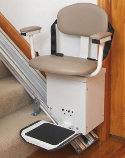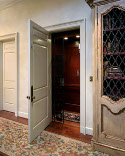Choosing the Right Lifting Aid to Increase Staircase Safety
Published by Stephen on August 15, 2009 Under stair liftsThere are quite a few different medical conditions and factors that can make it difficult to use the stairs. In many cases, these factors do not only make using the stairs difficult, but also more dangerous, increasing the risk of a staircase fall, which can be extremely serious. While this is a problem that predominantly affects seniors, having trouble using the stairs is something that can affect people of any age.
Problems using the stairs is an issue that is addressed in many ways. Sometimes, an elderly person will simply avoid the stairs all together or move to an assisted care facility, where the stairs are not an issue. Others choose to remain where they are and install a lifting aid to allow them to more easily use the stairs. There are a number of lifting aids, but typically they fall into the category of stair lifts or elevators.
Installing a Stair Lift
 Stair lifts are basically devices designed to move its rider safely between floors. Most provide a chair for the user to sit in, which is sent up and down the stairs on a metal track.
Stair lifts are basically devices designed to move its rider safely between floors. Most provide a chair for the user to sit in, which is sent up and down the stairs on a metal track.
Depending on the width of the staircase and the type of staircase, the track is either secured to the wall or the steps. Usually, a very narrow staircase or a curved staircase will require that the track is secured to the wall, while standard staircases have the stair lift track attached to the steps. Stair lifts can be installed onto both wooden and non-wooden staircases, but in the case of the latter special screws and anchors will be needed.
One of the most important aspects of a stair lift is that it can typically be installed without requiring major modifications to the home. The installation is also often something that can be preformed with someone with a basic understanding of tools and home construction, so it is not always necessary to use a professional stair lift installation service.
There are a few special types of stair lifts, including perch lifts and incline platform lifts. Inclined platform lifts are designed to transport a person in a wheelchair or mobility scooter, providing a platform that the mobility vehicle can be driven onto. They do, however, take up a great deal more space than stair lifts, so may not be suited for all residential staircases.
Perch lifts, on the other hand, also provide a platform instead of a chair, but the platform is much smaller, only large enough for a person to stand on. Perch lifts are popular among those who are not medically able to safely sit in a chair, such as after a knee replacement surgery, and are also unable to safely use the stairs. Since more balance is required when using a perch lift, they usually be used only in cases of medical necessity.
Another important consideration is whether to use a battery stair lift or a standard AC stair lift. The advantage of a battery stair lift, or DC Stair lift, is that it can be used if the power goes out in the home. However, they have a higher initial cost and the batteries must also be periodically checked and replaced, resulting in a higher maintenance cost than a standard AC Powered Stair Lift.
Residential Elevators
 Installing an elevator is also a consideration when faced with someone who can not use the stairs and for wheelchair users, this is often the best choice. However, residential elevators can be quite pricey and will require a major home renovation.
Installing an elevator is also a consideration when faced with someone who can not use the stairs and for wheelchair users, this is often the best choice. However, residential elevators can be quite pricey and will require a major home renovation.
One of the biggest hurdles, aside from cost, is finding a place for the elevator shaft, although many choose to install it in the place of a hall closet.
Elevators do have the advantage of greatly increased functionality and usability when compared to stair lifts, as well as increasing a homes value, so for those looking at the big picture, it might be a good investment.
There are several residential elevator kits available, as well as companies that can custom build these to fit the homes proportions.
No Comments |
Add a Comment